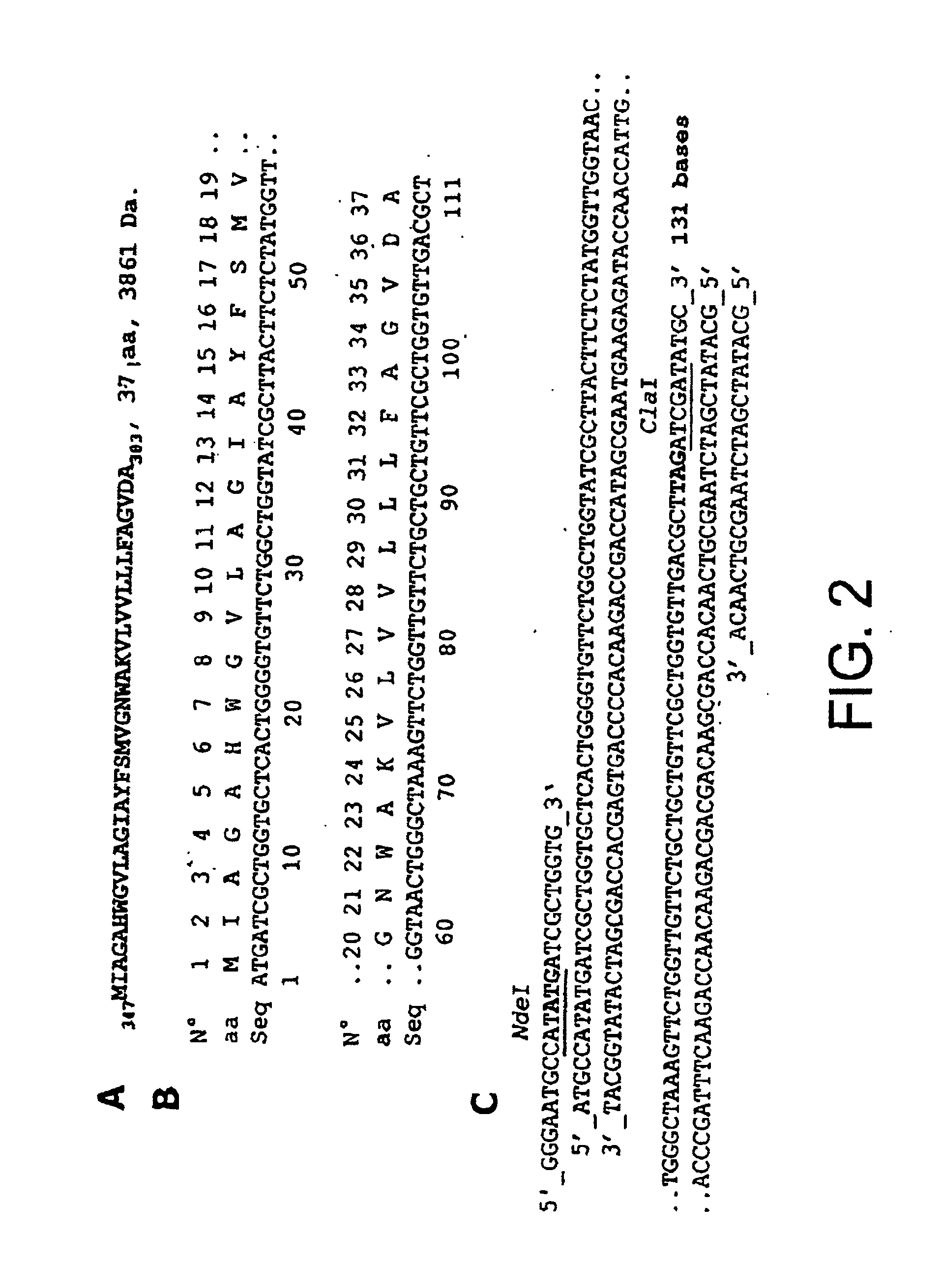Systems for expressing toxic proteins, vectors and method of method of producing toxic proteins
a technology of toxic proteins and systems, applied in the field of systems for expressing toxic proteins, can solve the problems of forming insoluble aggregates, causing death of bacteria, expression engendering varying degrees of toxicity, etc., and achieve the effect of suppressing the toxic effect of proteins
- Summary
- Abstract
- Description
- Claims
- Application Information
AI Technical Summary
Benefits of technology
Problems solved by technology
Method used
Image
Examples
example 1
Synthesis of the Expression System
[0094] 1.1) Construction of the pT7-7-ptTME1 and pT7-7-ptTME2 Expression Vectors
[0095] The DNA encoding the two domains was synthesized de novo using the appropriate oligonucleotides. The codons were chosen according to their greatest frequency of use in the bacterium, as was quantified by Sharp et al. [17]. The constructs are described in the attached FIG. 2 for TME1 and in the attached FIG. 3 for TME 2.
[0096] Each synthetic DNA was generated using a set of two long and overlapping oligonucleotides, OL11 (SEQ ID No. 9) and OL12 (SEQ ID No. 10) for TME1, and OL21 (SEQ ID No. 19) and OL22 (SEQ ID No. 20) for TME2, which were amplified after hybridization with two external oligonucleotides chosen according to the cloning in a given plasmid. Thus, the clonings in pT7-7 were carried out using the set of external oligonucleotides OL13 (SEQ ID No. 5) and OL14 (SEQ ID No. 6) for TME1, and OL23 (SEQ ID NO. 15) and OL24 (SEQ ID NO. 16) for TME2.
[0097] Ea...
example 2
Expression of Sequences Encoding the TME1 and TME2 Proteins Alone
[0112] The expression of the sequences encoding the TME1 and TME2 domains alone was tested by thermal or chemical induction and using various bacterial strains as described below.
[0113] 2.1) Thermal Induction System
[0114] The system developed by Tabor [22] makes it possible to express a protein by thermal induction using two vectors in the same bacterium, pT7-7 and pGP1-2.
[0115] The pT7-7 plasmid contains the DNA to be expressed, placed under the control of a φ10 promoter recognized by the T7 phage RNA polymerase. The pGP1-2 plasmid contains the gene encoding the T7 phage polymerase, placed under the control of a λpL promoter. This promoter is repressed by a thermosensitive repressor, cI857, that is itself also present in pGP1-2. At 30° C., cI857 is normally expressed and represses the λpL promoter, which blocks the expression of the polymerase and therefore also that of the protein of interest.
[0116] The inductio...
example 3
Expression of Sequences Encoding the GST-TME1 and GST-TME2 Fusion Proteins
[0129] The expression vectors were constructed as described in Example 1, and then introduced into the BL21 (DE3)pLysS bacteria. The BL21 (DE3)pLysS bacteria were used in the interests of comparison with the preceding experiments since the expression of GST or of its chimeras does not require the DE3-pLysS system.
[0130] The expression was induced with IPTG as for that of the domains alone. The characteristics of the proteins produced are summarized in Table 2 below.
TABLE 2Chimera,Size,MassPlasmidabbreviationConstructaaDapGEXKTGST, G1M-D23923927469pGEXKT-T1GST-TME1,1M-S233-347M-A38326930506GT1pGEXKT-T2GST-TME2,1M-S233-717E-A74626330191GT2
[0131] The amino acids (aa) are indicated with the one-letter code. The numbering of the sequences is done with respect to the proteins of origin, GST and viral polyprotein. That which refers to the membrane domains is indicated in italics.
[0132] Panels C and D of the atta...
PUM
| Property | Measurement | Unit |
|---|---|---|
| molecular mass | aaaaa | aaaaa |
| temperature | aaaaa | aaaaa |
| OD | aaaaa | aaaaa |
Abstract
Description
Claims
Application Information
 Login to View More
Login to View More - R&D
- Intellectual Property
- Life Sciences
- Materials
- Tech Scout
- Unparalleled Data Quality
- Higher Quality Content
- 60% Fewer Hallucinations
Browse by: Latest US Patents, China's latest patents, Technical Efficacy Thesaurus, Application Domain, Technology Topic, Popular Technical Reports.
© 2025 PatSnap. All rights reserved.Legal|Privacy policy|Modern Slavery Act Transparency Statement|Sitemap|About US| Contact US: help@patsnap.com



